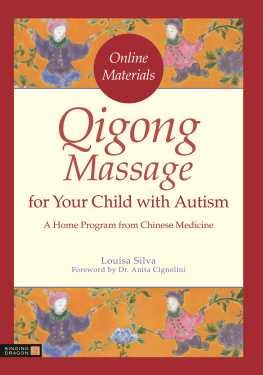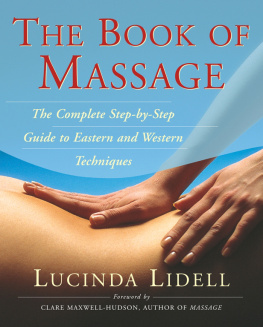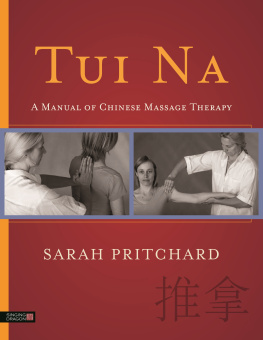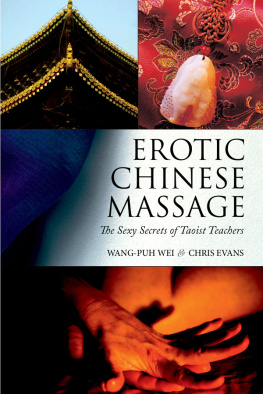
C ONTENTS
A CKNOWLEDGMENTS
ANY BOOK OF THIS SCOPE IS THE FINAL PRODUCT OF MANY peoples efforts. While I take responsibility for any errors, credit is due to many more people than would fit on this page.
I wish to acknowledge the many generations of doctors in China whose efforts have culminated in the current practice of Chinese pediatric massage. I would also like to acknowledge the generous help and support of my teachers and friends: Dr. Huang Dagang, Dr. Li Hong-wai, Dr. Zheng Shou-jie, Dr. Shen Yang-he, Dr. Lin, Dr. Ye, Dr. Ting Ji-feng, Wu Jun-miao, Nurse Lu, Ye Jing, and Antoine Eid.
I acknowledge the invaluable help of my teachers, colleagues, and friends in the United States: Bob Flaws, Honora Wolfe, Master Mantak Chia, Maneewan Chia, Subhuti Dharmananda, Dr. Edythe Vickers, Dr. Zhang Qing-cai, Judith Rose, Peggy Nauman, Sheila Lucas, Karen Sprute-Francovich, Aaron Norr, and Helaine Gross.
I greatly appreciate the support and assistance provided by the staff of Healing Arts Press, especially Peri Champine, Susan Davidson, Jon Graham, Blake Maher, and Virginia Scott, and copy editor Laura Jorstad.
Finally, my deepest appreciation to the many children and parents, both Chinese and American, who have contributed to my understanding of Chinese pediatric massage.
P REFACE
TODAY MANY ADULTS ARE EXPLORING A WIDE ARRAY of alternatives to the Western (allopathic) style of health care. Allopathic medicine offers many useful services but does not deal well with all conditions. This is as true for children as it is for adults. Unfortunately, there are few alternative medical models available for childrens health care in the United States.
This book describes a very sophisticated pediatric massage system that has been used in China for over one thousand years. It is not well known in the United States at this time, but that is changing. Throughout its long history in China, pediatric massage has proven to be a viable option for treating a wide variety of common childhood conditions.
This book was first developed to educate the parents of the children I was treating in my practice. Many parents were interested in learning how to give massage at home to supplement my treatments. Other parents wanted to know what they could do for simple conditions that did not require a professional massage.
The result is this reference book with which parents can learn how to use Chinese massage for their own children. You may use it to learn one or two points to ease a condition or to learn how to give a complete massage.
In simple cases the information in this book may be sufficient for home massage. In more difficult conditions massage may be one part of an overall treatment strategy that includes other types of medical care.
Another purpose of this book is to demystify the sometimes difficult concepts of Chinese medicine so that you as a parent can understand and use this information to benefit your children.
Pediatric massage is a specialty within the professional field of Chinese medicine. However, a degree in Chinese medicine or massage is not required to use this technique for simple conditions. The requirements to learn and perform pediatric massage well are:
- An open mind
- The intention to do well
- A willingness to try something new
- Staying within the limits of your abilities
At a time when many people are rethinking what kind of health care best suits their needs, looking to different medical models can provide a new perspective. The rapid growth and general acceptance of acupuncture in the United States is an indication of how Chinese medicine can be a useful addition to our overall health care. Pediatric massage is another aspect of Chinese medicine that could be one option in a complete and holistic approach to childrens health care.
H OW TO U SE T HIS B OOK
THIS BOOK IS ORGANIZED AS AN EASILY ACCESSIBLE reference for parents and is written to accommodate parents with varying degrees of interest, from those who want a very simple approach to treating their children to those who want more background information and depth. Some parents will use only the General Health Care massage plan as a means of maintaining good health. Others may also want to learn how to respond to simple colds or coughs, while still others may want to deal with more difficult conditions such as bed-wetting or asthma. You can use this book in all of these cases.
In order to get the most out of this book, I recommend the following process.
G ET A CQUAINTED WITH E NERGETIC P RINCIPLES
Before venturing into the techniques or massage plans, take a few minutes to read about energetic principles in for clarification. Your understanding of energetic principles will increase as you actually do the massage.
L EARN ABOUT A SSESSMENT S KILLS
Assessment is an important part of choosing the appropriate massage plan. The information presented in is very general and basically requires good observation skills. Knowing these simple skills can provide much information on the energetic health of your child.
P RACTICE THE T ECHNIQUES
The techniques used in this book are easy to learn; however, they do require some dexterity and practice. will explain how to practice the techniques before you use them on your child.
B ECOME F AMILIAR WITH THE M ASSAGE P LANS
It is useful to look through some of the massage plans in to see how they are organized before you need them. If you are familiar with the basic idea of the massage plans from the start, they will be much easier to use when the situation calls for it.
F EEDBACK OR Q UESTIONS
I appreciate any feedback or questions you may have. You may write to me at Kyle Cline, P.O. Box 10714, Portland, OR 97296. You may also reach me by e-mail (kyle@healartspro.com).
Learning about a therapy such as Chinese pediatric massage from a book has limitations. For additional information about other reference books and videos, consult appendix C: Recommended Resources. More detailed and individualized advice can be obtained from qualified practitioners of Chinese medicine.
I NTRODUCTION
CHINESE PEDIATRIC MASSAGE (CPM) IS ONE TYPE of therapy used within the framework of traditional Chinese medicine (TCM). TCM consists of three main branches: acupuncture, herbs, and manipulation (or massage). Pediatric massage is a specialty within the manipulation branch of TCM.
Therapeutic massage is capable of influencing a childs energetic flow in the same way that acupuncture works for adults. However, because there are no needles you will find less resistance to and fewer side effects from the massage. CPM is a useful therapy for children from birth to approximately twelve years of age, although it is mainly used for children under six. In general, the younger the child, the more effective these techniques will be.
Massage is one way to use the sophisticated and complete system of Chinese medicine to promote good health and healing in children. While other TCM therapies (notably acupuncture and herbs) may be used, massage is particularly appropriate for children for several reasons. First, childrens energy is very accessible. Relative to adults, children have very few barriers or defense mechanisms in place. This results in less need for invasive techniques and consequently less resistance to treatment and fewer side effects. Second, massage involves the very personal, communicative, and bonding process of touch. Using your hands to feel, touch, and massage your child may result in a better response and bonding process. Finally, massage can be performed at home, while traveling, or elsewhere, providing ongoing support for your child generally or for specific conditions.









